Interwar Athens: A Journey Through Architectural Transformation
We join archaeologist and MONUMENTA coordinator...
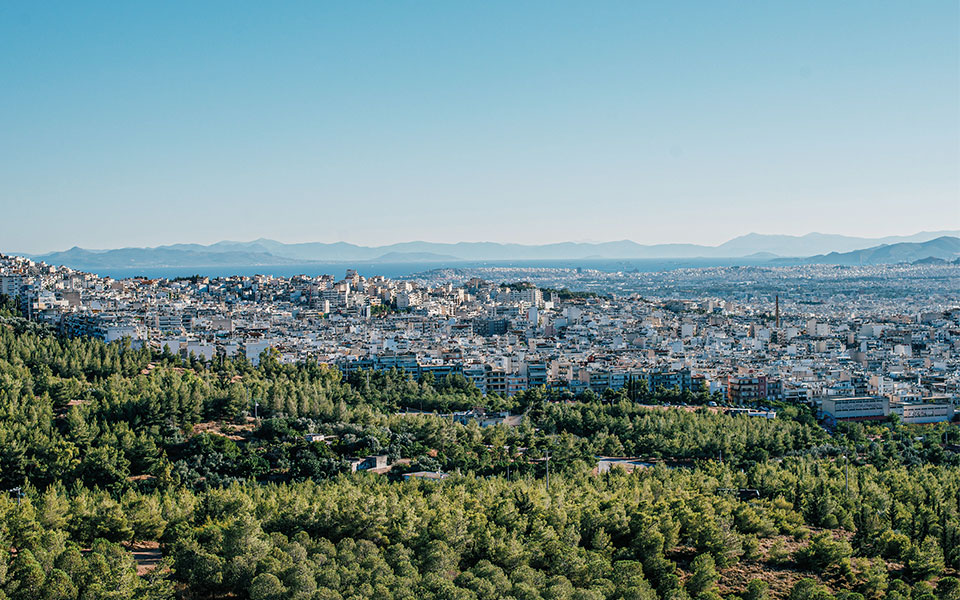
A view of the city from the hills of Tourkovounia.
© Angelos Giotopoulos
We entered the park at the Veikou Grove and ascended a meandering pathway, passing first a playground and then the Alea Café, still closed after the lockdown. As we ambled higher and higher around the hill, we came to a turn where we met Lykourgos and his dog, Thelma, on the way to pick wild fennel and sage. We followed them along a narrowing dirt path, where we were eventually surrounded by aromatic bushes on the northernmost slope of the hill, overlooking the Olympic Stadium, which resembled the skeleton of a dinosaur far below. Above us, there was a rocky ridge with a lookout point at its summit, from which hikers watched us.
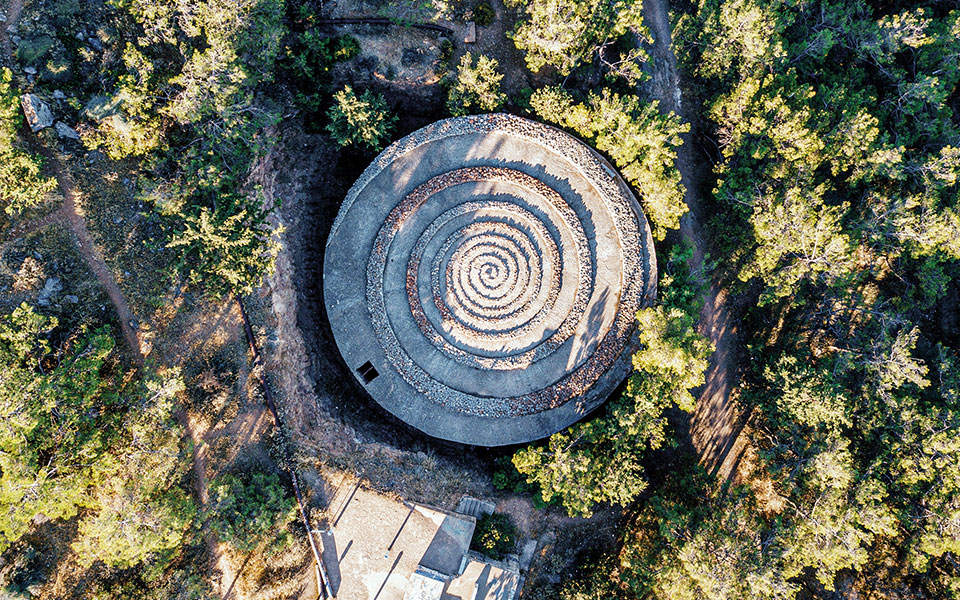
The sculpture Spiral 1, by artist Mikaela Karagianni, on Filothei Hill.
© Angelos Giotopoulos
Legend has it that Zeus threw lightning and thunder from the zenith of what is now called Filothei Hill, and there’s a plaque marking the stone foundations, near the lookout point, of a Classical-era altar where animals were sacrificed in order to bring rain. Called the Throne of the Umbrian Zeus, it has a vista fit for the gods, extending as far as the island of Aegina on a clear day. Artifacts evidencing human presence back to 3,000 BC have been found there, along with the walls of a sacred building from the late Geometric period (700 BC) containing figurines and vessels used in the worship of Homeric heroes.
We descended into Filothei along leafy Karaiskaki Street, passing by “Spiral 1,” a sculptural stone formation created by artist Mikaela Karagianni atop an abandoned water tank, evoking a Neolithic-industrial time portal, near the intersection with Bouboulinas. Further down, as the sounds of the city grew louder, we encountered the Konstantinos Karamanlis Foundation (dedicated to the memory of the 20th-century Greek statesman) and an abandoned Modernist villa. By then, our experience seemed so surreal that I began to think Lykourgos was a figment of my imagination. When I asked if his name meant “wolf” – the Greek word for “wolf” is “lykos” – he smiled and said that it meant “light.” Strangely enough, between the 3rd and 5th centuries AD the range was called Lykovounia – they say either because wolves dwelled there, or because of the way the slopes were illuminated by sunlight.
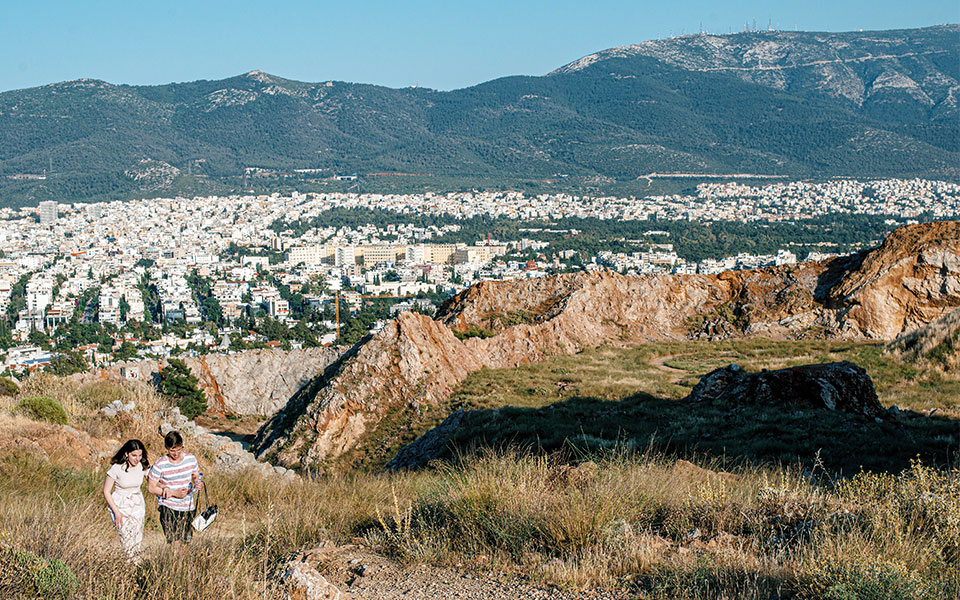
© Angelos Giotopoulos
Lushly vegetated with pines and olive trees and inhabited by wild animals, Tourkovounia was a leisure destination for Athenians until the early 20th century. In January 1877, the newspaper Alitheia (“Truth”) reported that a wolf came out of the hills and killed 120 sheep. At the time, Galatsi was a remote agricultural community with a population of around 250. Over coffee one morning, former Greek army general Emilios Tzenakis told me that the military used the hills for shooting practice in the 1890s. A highly anticipated European-style fox hunt, planned by the palace in 1894, was satirized in the satirical newspaper Skrip – and postponed due to bad weather.
By the 1930s, when the city was modernizing and the population was exploding with immigrants displaced from Asia Minor, more and more trees were being felled for fuel, and limestone quarries were set up to provide materials for the construction of refugee housing in new settlements such as Nea Ionia and Nea Filadelfeia. Straddling the urban districts of Kypseli, Galatsi and Nea Ionia to the west and Filothei and Psychiko to the east, the three hills of the Tourkovounia – now called Filothei Hill (north), Damaria (central) and Attican Grove (south) – comprise the highest peak in the Attic Basin, at around 340 meters. The most logical explanation behind the colloquial moniker is that it is where Ottoman general Turahanoglu Ömer Bey camped his troops in preparation for the conquest of Athens, in 1456.
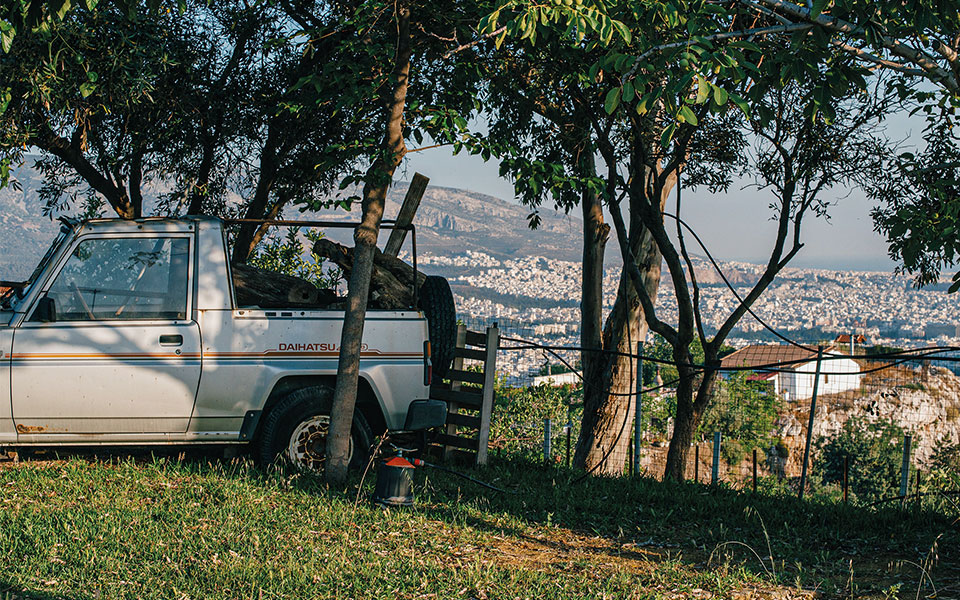
The view from atop the Attican Grove.
© Angelos Giotopoulos
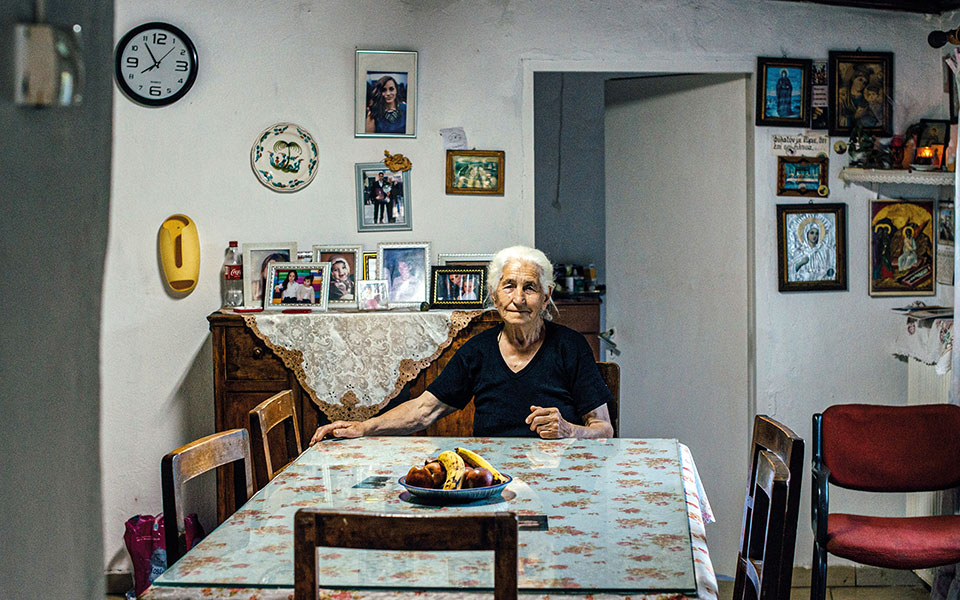
Athinoula Nasou at home in the Georgios Papandreou Settlement.
© Angelos Giotopoulos
Late one Sunday afternoon, we sped uphill by motorcycle, past the abandoned ruins of the Astir Lato quarry and its towering kiln chimney, to the top of Damaria, just south of Filothei Hill. At the top, we emerged onto a barren lunar landscape of dramatic rocky outcrops carved by decades of limestone excavation. The asphalt was covered with shards of broken glass, and a bicyclist with a flat tire said he was facing a very long walk back to Koukaki. Called the Meadow of the Gods, the plateau was nearly empty; it had the windswept look of the Wild West as seen in films – surrounded by the mesmerizing urban mosaic of Athenian apartment building rooftops at its feet. At the western precipice, we encountered Nikos Ganos and Tasos Xiarcho shooting their new music video “Déjà Vu,” accompanied by nine young dancers dressed in faded jeans.
More battlefield than playground of the gods, this eerie aerie has an enchanting beauty and an allure derived precisely from its end-of-the-world feeling of desolation: Mad Max comes to mind. After quarry activity ceased in 1976, the municipality drafted plans for the regeneration of the postindustrial site with a cultural center and public park, but since then the land has been tied up in limbo while the Greek state and the development company, Kekrops, spar in a series of lawsuits and appeals. That hasn’t stopped people from enjoying the craggy scenery, by now softened with wispy greenery here and there; as we watched, a young couple on a romantic walk passed by and ascended, just in time for sunset, to the top of a precipitous promontory above us.
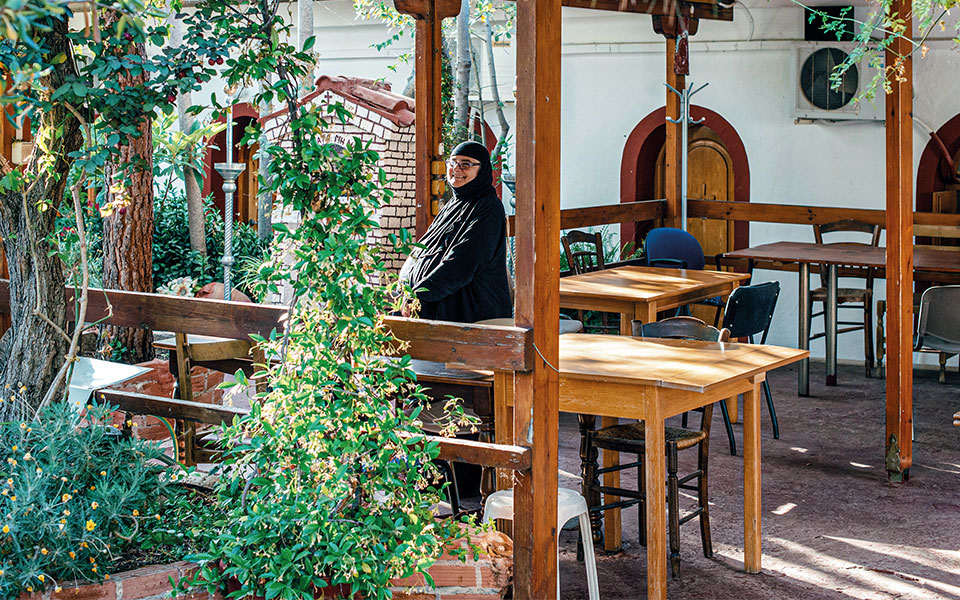
Sister Filothei in the courtyard of the monastery Profitis Ilias, built in 1957.
© Angelos Giotopoulos
The real pioneers of Tourkovounia were the first settlers on the summit of Attican Grove, who started building houses on plots purchased from private landholders in the mid-1940s. Many of them were men who came from Epirus in search of work and eventually relocated their families, too. In the riveting documentary “In Tourkovounia” (1983), by director Lefteris Xanthopoulos, the original inhabitants recount their struggles with the authorities of successive governments and with quarry owners for the right to live on the land. In 1947, Vassilios Hatzaras bought a plot of land for 6,000 drachmas in exchange for a receipt written on a cigarette pack. The uninhabited hill, used mostly for grazing, was a legal gray area: “I built a small house and they demolished it, and I went to jail for 15 days. I got out and built it again and they demolished it again. They’d demolish and I’d build again at night,” he says.
In the 1960s the settlement was named after Prime Minister Georgios Papandreou, who had promised to get it approved for legal residential building. His government fell before he succeeded and when the military junta came to power, its leader, Georgios Papadopoulos, ordered the expropriation of the area for the construction of a monumental church in fulfillment of the “Vow of the Nation” – an idea first hatched after Greek independence from the Ottomans in the 1820s. Bailiffs arrived with notices of eviction, but nobody moved. “On April 24, 1967, the police came and burned 80 to 90 houses,” Thomas Douchaniaris says. “My house was burned three times: in 1940 by the Germans, in 1947 in the civil war and in 1967 with the dictatorship.” The 450 million drachmas raised for the construction of the church vanished, and it was never built.
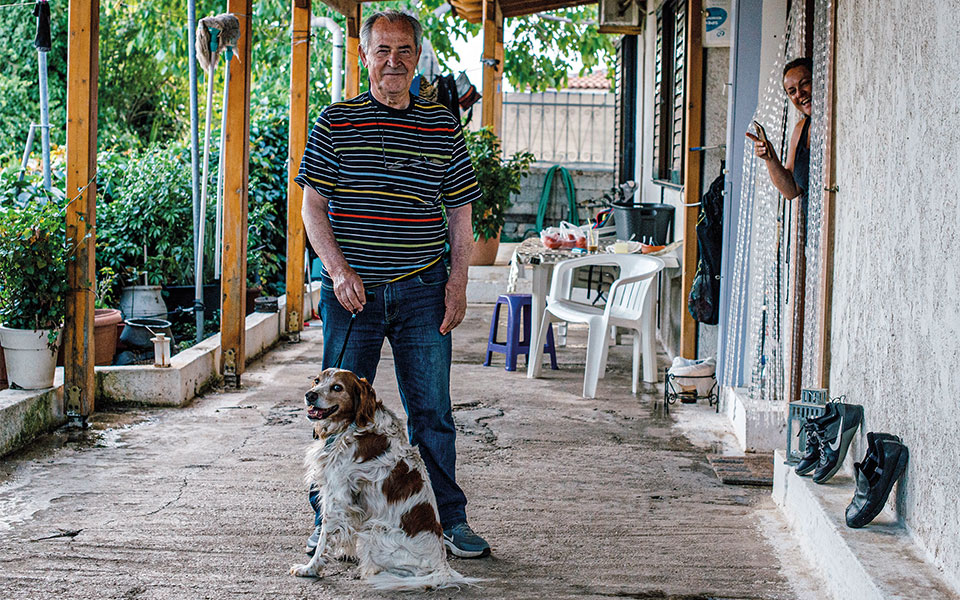
Dimitris Karambikas at home with his daughter Georgia and his dog in the Georgios Papandreou Settlement.
© Angelos Giotopoulos
Today there are 145 houses and a population of around 800 people. The first of a second wave of settlers, Dimitris Karambikas arrived from Arta, Epirus, in 1964 and bought a plot from the Karagiannis family, the original owners of much of the land from the Ottoman period. After the fall of the dictatorship, the area was transferred to the Economics Ministry as state property, and a park was planned. In 1977, the residents successfully obtained titles for the houses – and since then they have been paying both home ownership taxes and penalties for “arbitrary” use of public land. “We’ve taken the case to the European courts,” Karambikas said as we sat on a veranda in the evening breeze one Sunday. “We’re a village waiting for a solution.”
“Life goes on,” says Athinoula Nasou, who has lived there for 50 years. A lively white-haired woman who lives in a rambling house with a large vegetable patch, chickens and a ginger cat, she’s been on her own since her brother’s recent death. “I have to keep going or I’ll rot away.” She stays busy cleaning and tending the garden – and insisted that we take some eggs and garlic.
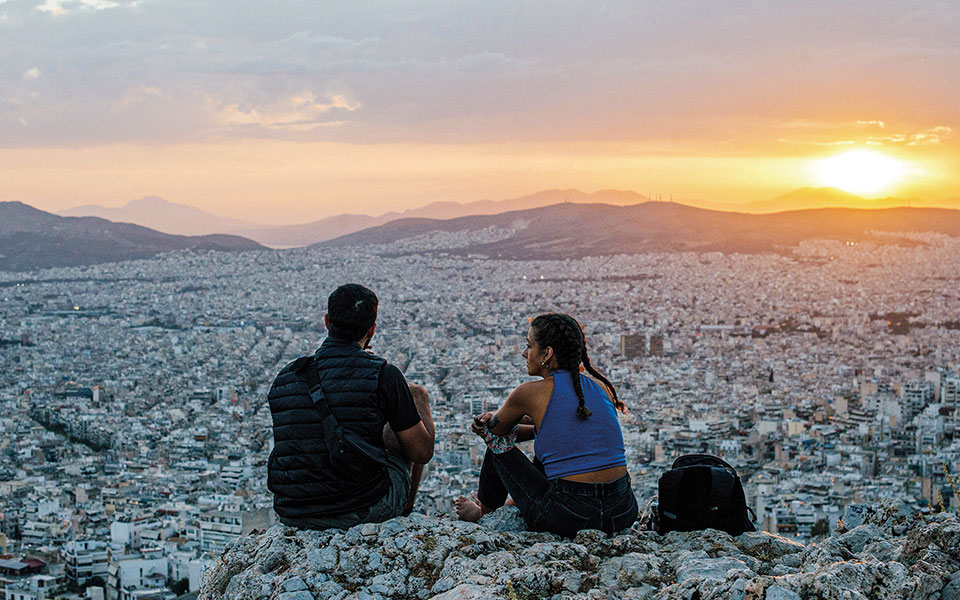
Taking in the sunset and the view of Athens from Cuckoo Point.
© Angelos Giotopoulos
Maria Marinakou, president of the Georgios Papandreou Settlement Cultural Association, has applied to have the enclave designated an official traditional village. In 1993, the government constructed roads, a public water supply and a street lighting network, incorporating the settlement into a district of the municipality. A mountain hamlet in the middle of the city, complete with a small church, Aghia Kyriaki, built by the community in a shady square, it recalls the musical Brigadoon, which is about a Scottish village that appears for only one day every 100 years.
Georgia Liapi, a contemporary art curator, grew up in a house built by her father, who added rooms one at a time as four children were born. Her aunts and uncles lived on the same street, which has stunning views of Lycabettus Hill and all the way to the Saronic Gulf. “When my mother made pitas, there always had to be enough to take around to the neighbors.” There’s never been public transport to the top, so children had to be driven or walked to school every day. “My biggest fear as a child was to wake up at night to the sound of bulldozers,” Liapi says. The perks are a sense of community and fresh air that is a few degrees cooler than the noisier city streets below.
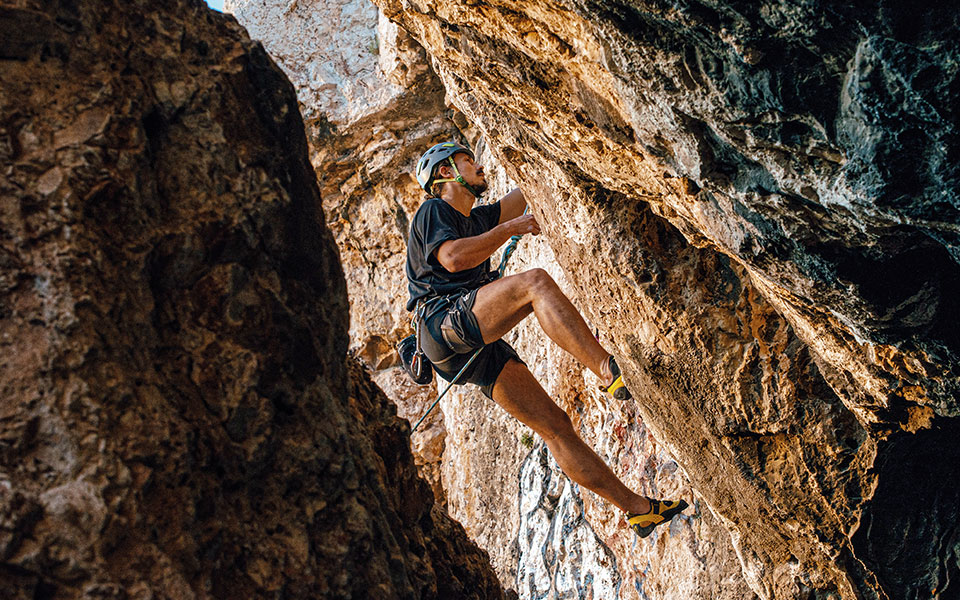
A rock climber in action on the southwest side of the Attican Grove.
© Angelos Giotopoulos
Liapi led us to a childhood cliffside hangout called Cuckoo Point, named for the bird that was said to perch there every evening. Young people were sitting around and watching the sunset. There was litter everywhere, and a recently built shelter was already covered with graffiti. The only real crime in this idyllic place is the way some people treat it. “The problem is created by people between the ages of 16 and 20,” says Vassilis Sfakianopoulos, whose wildly successful national cleanup campaign “Save Your Hood” started on Tourkovounia, near where he grew up in Kypseli. “The amount of trash has already been reduced by 78 percent, and we’ve organized educational courses at the schools around the hill.”
We took a dirt trail towards Kakarapi Cave and met a group of rock climbers, accompanied by a dog named Socks, who were scaling the sheer preci pice of a crag. Mountain climber Fotis Theocharis has recently marked and anchored three routes in the area. Legend has it that, in the late 19th century, the ruthless robber Loukas Beloulias, aka Kakarapis, hid out in the cave and stashed his treasure somewhere nearby. We never made it that far – just watching the crew scaling the cliffs made me dizzy. An easier excursion is at the other side of the hill, where the spectacular chambers of Sotiros Cave can be accessed via a fenced entrance to the northwest of the Katina Paxinou Attica Grove Theater.
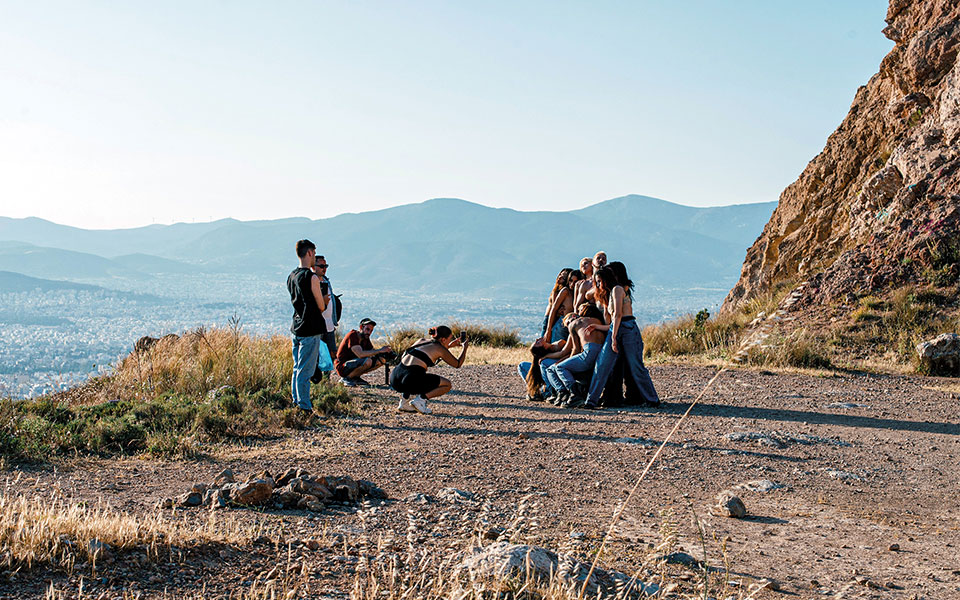
Singers Nikos Ganos and Tasos Xiarcho shooting their music video “Déjà Vu” at the Meadow of the Gods on Damaria.
© Angelos Giotopoulos
From where we were, we could see the convent of Profitis Ιlias, built in 1957, on the bluff opposite. We went over and rang the bell at the gate just after visiting hours, and the door swung open, as if by magic. An elderly nun sitting in the courtyard waved us in the direction of the church – and its expansive terrace with a breathtaking panorama. Carpets were hanging out to air over the edge of the terrace railing, and one of the three resident nuns gestured towards the sea to express the extent of the view.
A fat ginger cat caressed my legs as Sister Filothei told us they had just put on a play about the original Cinderella: Rodopi, a Greek slave from Thrace who, according to the historian Strabo, was taken to Egypt by pirates. As she bathed one day, her sandal was snatched by an eagle and carried to Memphis, where it fell into the lap of Pharaoh Psamtik, who ordered a search for its owner. Of course, he married her and she became a princess. I looked down and saw a curious gate that opens from the terrace out over the cliff, as if one could fly through it and away over the city.
We join archaeologist and MONUMENTA coordinator...
Discoveries along Amalias Avenue, from the...
The workshop of famed tile painter...
Only a short drive from Athens,...